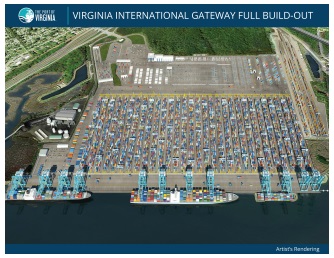
Virginia: Port Authority Signs New, Long-Term Lease for Virginia International Gateway; Lease Clears the Way for Port to Double the Terminal’s Annual Lift Capacity

The Port of Virginia® has signed a new, long-term lease for Virginia International Gateway (VIG). The deal clears the way for doubling capacity at the deep-water container terminal.
"This is an historic event for The Port of Virginia," said Gov. Terry R. McAuliffe. "This new lease helps to put the port on the path to long-term sustainability which, in turn, will result in continued job creation, investment and revenue for the Commonwealth."
The new lease will give the port oversight of and operating rights at the terminal until 2065. It also allows the port to begin work on a $320 million project to build the terminal’s second phase; construction will begin this year.
The lease is between the Virginia Port Authority (VPA) and Virginia International Gateway Inc., which is owned by Alinda Capital Partners and Universities Superannuation Scheme (USS). The lease takes effect November 1.
"Within the existing footprint, we will have the capability and capacity to process a total of 1.2 million [container] lifts – 2 million TEUs -- annually through VIG," said Aubrey L. Layne, Virginia secretary of transportation. "The negotiation process was a collaborative effort with both the Alinda, USS team and the port making a significant investment in resources and time. Everyone worked together to reach this agreement knowing the long-term benefits to the port and throughout Virginia."
VIG now processes some 600,000 container lifts annually. The terminal is served by eight ship-to-shore gantry cranes. CSX and Norfolk Southern provide on-dock rail service. The expansion will take an estimated three years to complete and result in a longer berth, an expanded rail operation, an enlarged container yard and four new ship-to-shore cranes.
"The potential economic impacts of the build-out are significant," said VPA Board Chairman John G. Milliken. "We anticipate this project creating thousands of new port-related jobs and generating hundreds of millions in state and local taxes and billions of spending and investment throughout the state."
The VIG lease signing follows recent announcements made by the port in its effort to reinvest and expand capacity. In August, Gov. McAuliffe announced $350 million in state funding to expand capacity at Norfolk International Terminals (NIT), the port’s other primary container terminal. Additionally, construction in nearly half complete on the NIT North Gate complex – a 26-lane gate that will provide greater motor carrier access to the terminal and tie into the I-564 connector, also under construction.
"We believe that the continued investment in people, technology and those capacity projects being undertaken here during the next three-to-four years are positioning The Port of Virginia to become a true gateway to world trade and a catalyst for commerce in Virginia," said John F. Reinhart, CEO and executive director of the VPA. "We are seeing vessels in the 10,000-plus TEU range, we are processing more rail cargo than ever and the demand for our services is growing. We have momentum and our timing coincides well with the changes in the industry."